We’ve just pushed live a new Postalytics Agency Edition update, a major new release of Postalytics with important new features that will help users get more done, scale their operations more efficiently and ultimately deliver better direct mail campaigns.

There’s a tremendous amount of new software in this update that will continue to help automated direct mail look, act and feel more like a digital marketing channel. We’re excited to share it with you!
Table of contents
- Financial Management Tools in the Postalytics Agency Edition Update
- Flexible Agency Edition Payout Margins
- Distribute or Transfer Direct Mail Credits to Client Accounts
- Direct Mail Credit Transactions – Account Level Credit Management Reconciliation
- Spend Limit Tool: Cap Your Automatic Credit Ordering Each Month
- Billing Activity Page: Replaces Orders & Invoices Pages
- Credit Card Failures
- Agency White Label Feature Updates
- Template Distribution Tools
- Other New Agency Level Tools
- Nonprofit (U.S.) and Self-funded (U.S. and Canada) Postage Permits
Financial Management Tools in the Postalytics Agency Edition Update
We’ve built out several long-requested features that will make the job of managing your Agency Edition account far easier.
Flexible Agency Edition Payout Margins
While Postalytics has long offered agencies the only solution to enable “margin” to be added to direct mail campaigns with automated payouts, the margin was limited to one setting for all client accounts. While that works great for some Agency Edition customers, others have different business relationships with different clients that call for flexibility in the way that margins are applied.
Now, you can set a default payout margin and/or individual payout margins per client account. The payouts will work the same way, clearing into your bank account within 2 business days.
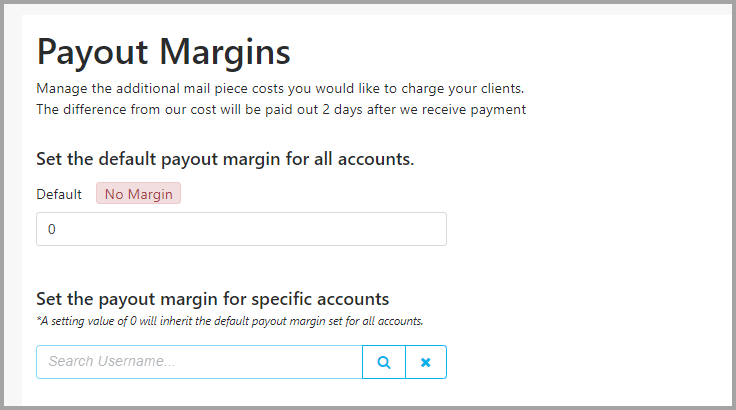
To learn more about how the new Payout Margins tool works, click here to view our Knowledgebase article.
Distribute or Transfer Direct Mail Credits to Client Accounts
The Postalytics Direct Mail Credits feature is a huge hit with clients, enabling the “bulk purchase” of credits that save money while giving flexibility in the use of those credits to pay for campaigns of any size.
Agency Edition customers have been looking for a solution to enable them to move their purchased Direct Mail Credits between Client Accounts. This release gives them a fast and easy way to do this. Why? A couple of key reasons:
- Clients would like to bulk purchase for all of their accounts to save the maximum amount, then distribute those purchases based on business need.
- Clients open or close down individual Client Accounts and need to transfer purchased credits accordingly.
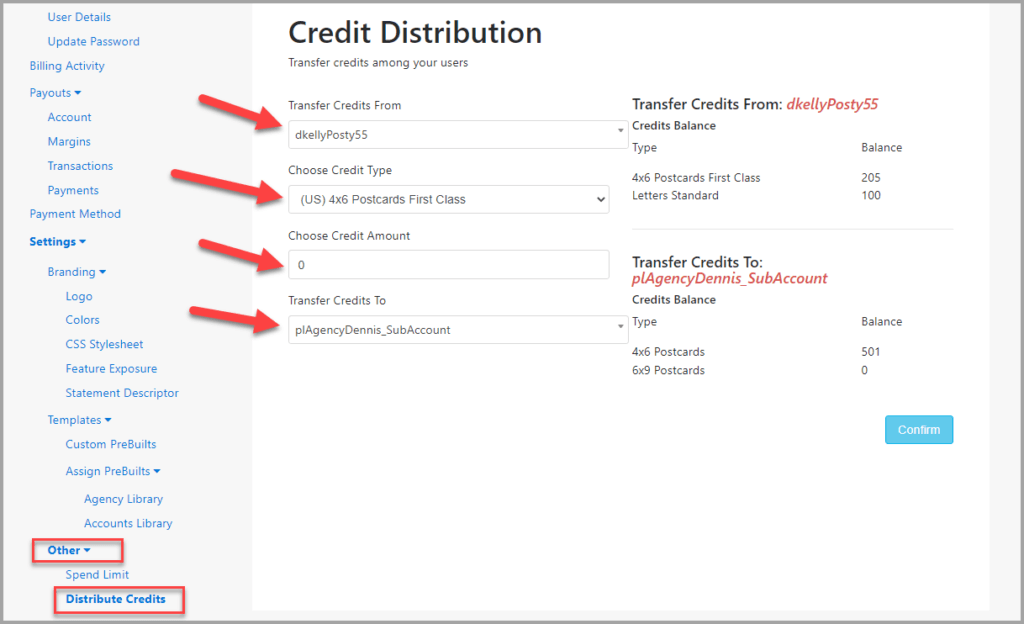
As you can see, the process is very straightforward. Simply select the Client Account you’d like to transfer the credits from, then choose the format, number of credits and the Client Account you want to transfer the credits into. Postalytics will show you the balances of both Client Accounts before and after the transfer. We’ll even record the transfers in the Credit Transactions (new feature) in each Client Account involved in the transfer.
Direct Mail Credit Transactions – Account Level Credit Management Reconciliation
Where are those credit transfers recorded? Right along side the credit purchases and other transactions being recorded in the new Direct Mail Credits Transactions tools.
Now, when you click the action button for any of the direct mail credit formats in a client account, you’ll see three options: Buy Credits, Transactions and Settings.

Buy Credits works exactly the same way as it has, just click there and buy credits as you need them. Settings is where you can change your credit reorders from manual to automatic as appropriate.
Transactions is a whole new set of tools that will help you reconcile your direct mail credit purchases, which campaigns used which purchases, and any transfers that you conduct between client accounts.
When you first enter the Direct Mail Credit Transactions page, you’ll see a history of all of the credit purchases and transfers that have been made for the format you’re viewing. You can enter a start and end date, and you can download the detailed data into a .CSV file for offline analysis.
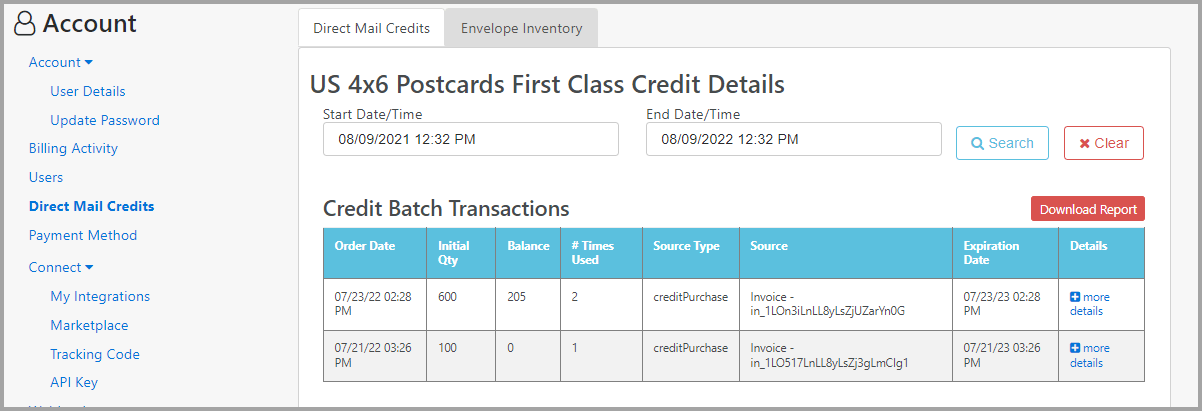
If you drill into the “more details” button, you’ll find a complete history of the usage of the purchase or transfer you’re viewing. This way, you know exactly which campaigns are using which credits. Once again, you can download these details into a .CSV file at any time.

Credits are used by your campaigns in the order in which they were purchased, similar to a “FIFO” (first in, first out) inventory model. So, your oldest credits are used first, your newest credits are used last.
Spend Limit Tool: Cap Your Automatic Credit Ordering Each Month
The new Spend Limit tool is also designed to help you manage your direct mail credit “automatic” ordering. Many Agency Edition customers purchase direct mail credits and have the “reorder” process set to automatic, as opposed to manual. This way, the software will reload credits each time the campaigns drawn down credits, and you don’t have to remember or worry about making manual purchases during the month.
The new tool is designed to let you set up a monthly “Spend Limit” for all or individual client accounts.
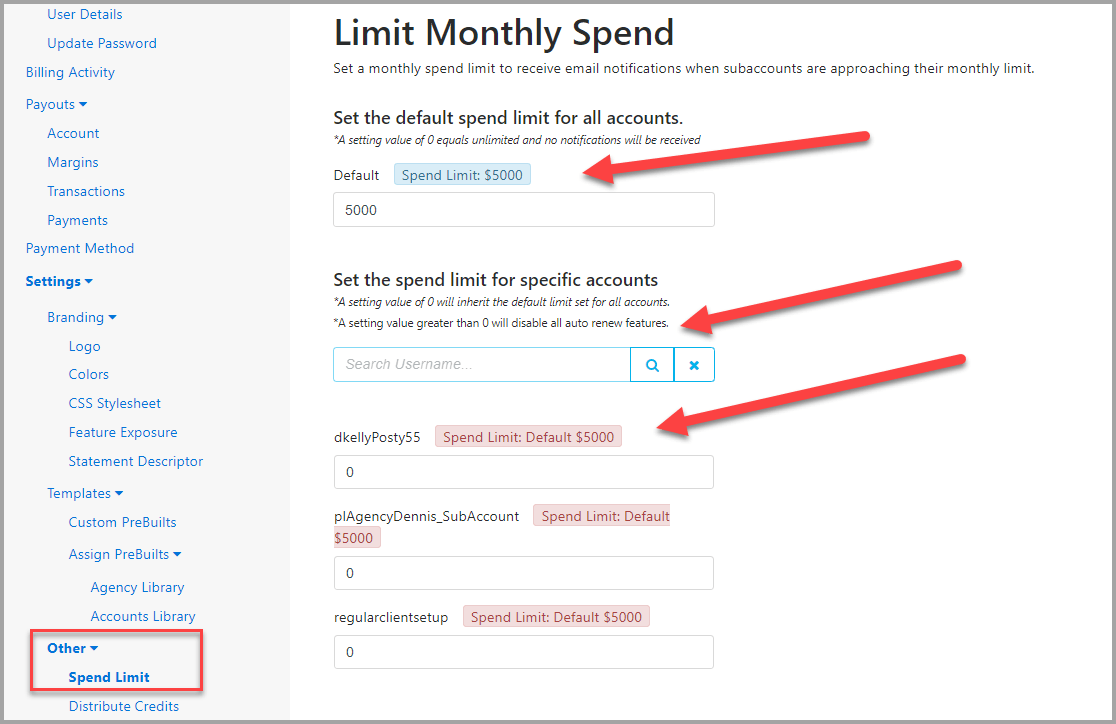
During the month, the software will keep track of the total orders spending, and if you’ve set up a limit on a client account:
- First send out a warning email and a dashboard notification when the account has spent 90% (10% left) of the limit.
- When the account has spent the entire limit, the system will send out a warning email, dashboard notification, and change any direct mail credits from “automatic reorder” to “manual reorder”. Thus, shutting down any automatic ordering that exceeds the limit.
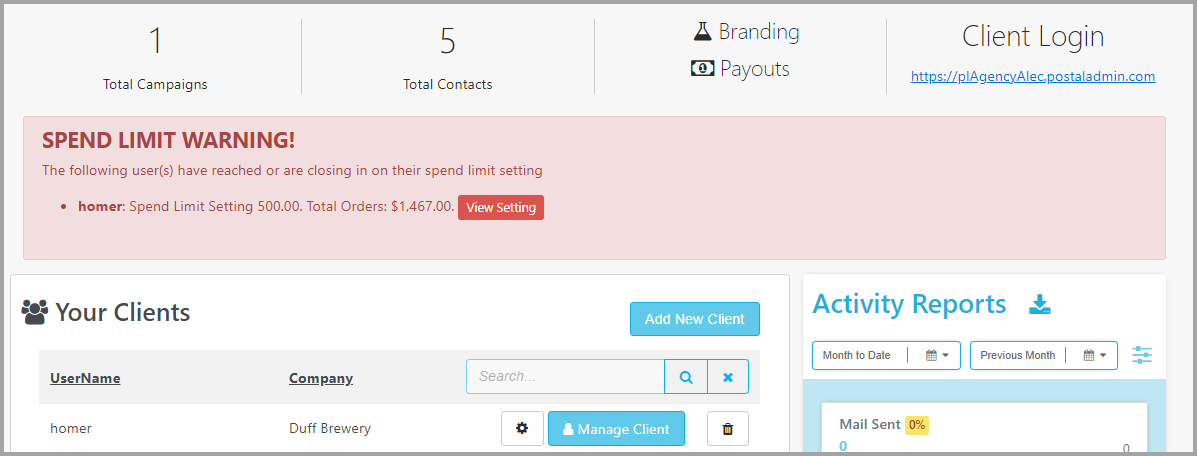
This is not a “hard” limit, you can still make manual purchases of credits or purchases that hit the credit card on file through the Smart Send Wizard.
If you do hit the limit and you want to re-establish automatic credit ordering, you’ll need to do that manually. There’s currently no automated process to re-establish automatic ordering each month.
Billing Activity Page: Replaces Orders & Invoices Pages
This is a simple change; we’ve collapsed two different menu items into one. Orders (campaigns or credits) and Invoices (subscriptions and other invoices) are now displayed together with an Invoice Type description to enable distinction between them.
Credit Card Failures
Another small change, if any credit card in an Agency Account fails, you’ll get a notification in the Home Dashboard, in addition to the email alerts that are sent.
Agency White Label Feature Updates
We continue to build out our industry leading white label tools, enabling you to put your brand front and center with your clients. In this release, there are two key updates.
Menu Options
We’ve taken the individual components of the previous Branding page, expanded the features, and made individual pages for Logo and Color management, CSS Stylesheets, Feature Exposure and the Credit Card Statement Descriptor.
Credit Card Statement Descriptor
A new feature in the “Branding” section of the new Settings menu option, the Credit Card Statement Descriptor page enable you to manage the way that charges that are run through your Agency account appear on the credit card statements of the cards entered into the client accounts.
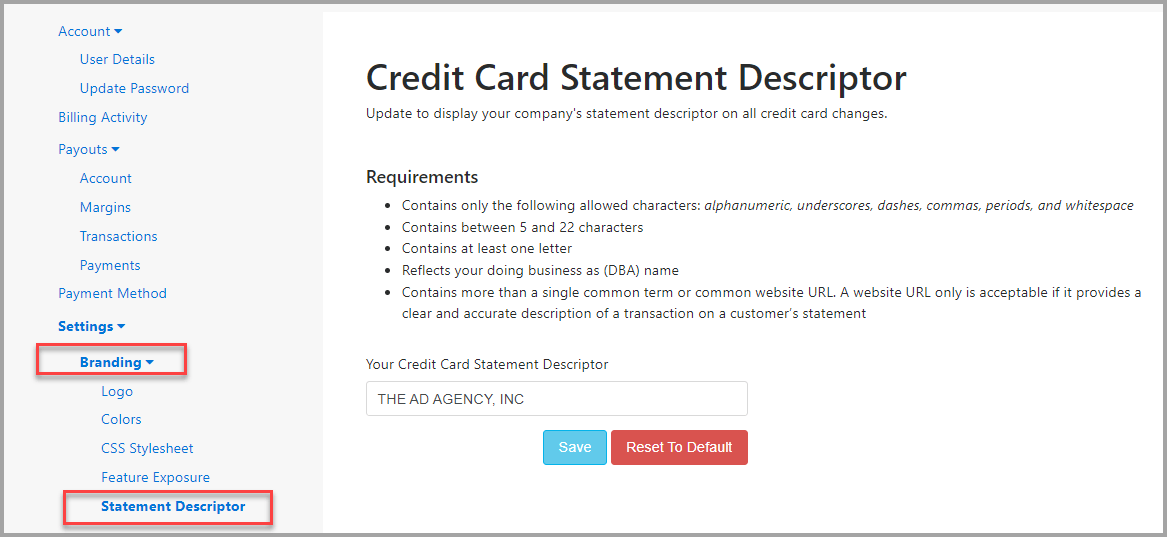
Feature Exposure
We’ve built a page dedicated to the ability to hide or show certain features in your client accounts now. The Feature Exposure page will let you toggle features on or off for all of your client accounts. You can now choose to hide or show:
- Credit card payment options – thus limiting your client accounts to using direct mail credits only
- Payment method – this will enable or hide the ability for your client accounts to enter or maintain their credit cards
- Home Dashboard Credit Balance – you can hide or show the dashboard notification sidebar for credit balances
- Prebuilt templates – you can hide or show the Prebuilt templates when creating new creative templates in client accounts
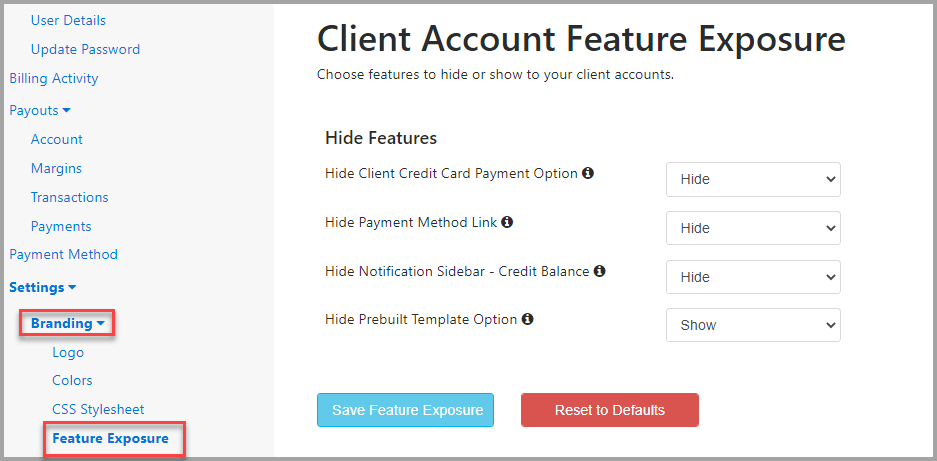
Note, these controls only will hide features for those who login to their client portals. If you use the “Manage Client” tools from the Agency Home Dashboard, you’ll always see full functionality.
CSS Stylesheet
In addition to the “Colors” section of the Branding tools, you can further modify the user experience of your clients by adding custom CSS into your account. There’s no limit to the size of the file that you can use, the sky’s the limit!
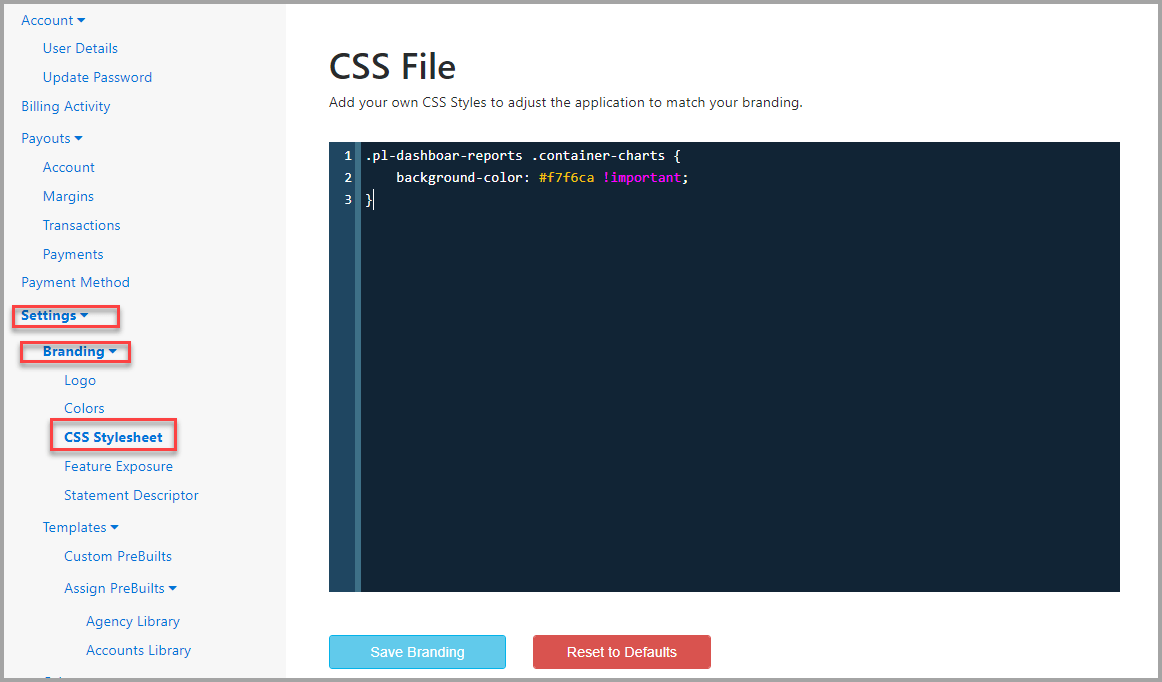
Template Distribution Tools
We’re really excited to announce these new very powerful features that enables Agency Edition customers to determine which direct mail templates they want to distribute to their client accounts.
Agency Level Template Management
Postalytics has always had powerful template editing and proofing tools, located only in client accounts. We’ve offered an easy way to copy templates from one client account to another, but we’ve never offered a centralized mechanism to create and manage templates from the Agency level. That’s all changed with this release.
Now, Agency Edition customers can use the “Templates” menu options to build, proof and manage custom templates, as well as determine which templates will appear in the Prebuilt libraries of which client accounts.
Template Filters
By offering centralized template creation and management, Agency Edition customers will be building very large libraries of templates. To assist with the management of these libraries, all of the new Agency Template tools have a powerful filtering system located on the left-hand side of the page. These filters let you select which templates you want to modify or manage with a few clicks.
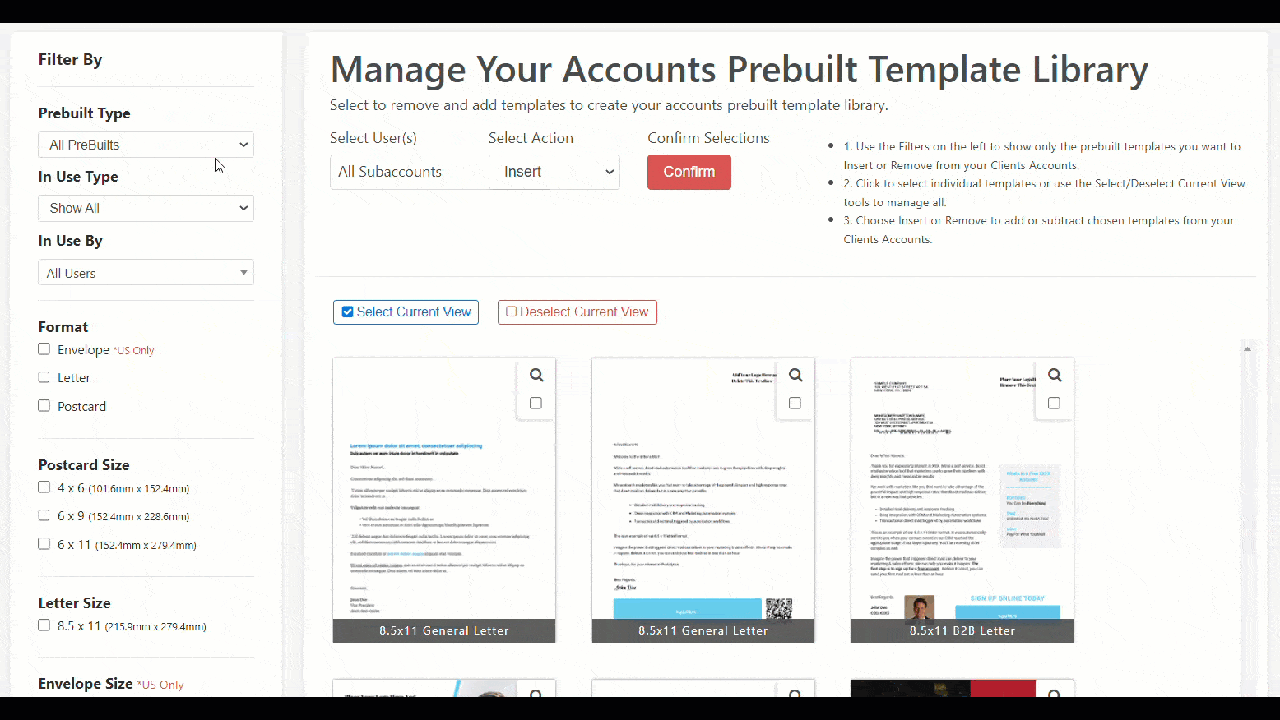
Custom Prebuilt Templates
The Custom Prebuilt Template tools enable Agency level creation and editing of templates. We’ve taken a version of the exact template editing and proofing tools that exist in client accounts and made them available here. So, you can now create new custom templates from scratch using the Postalytics editor, you can modify templates from the Prebuilt library that we provide, or you can upload your own template artwork and then finish off the templates in the editor and proofer.
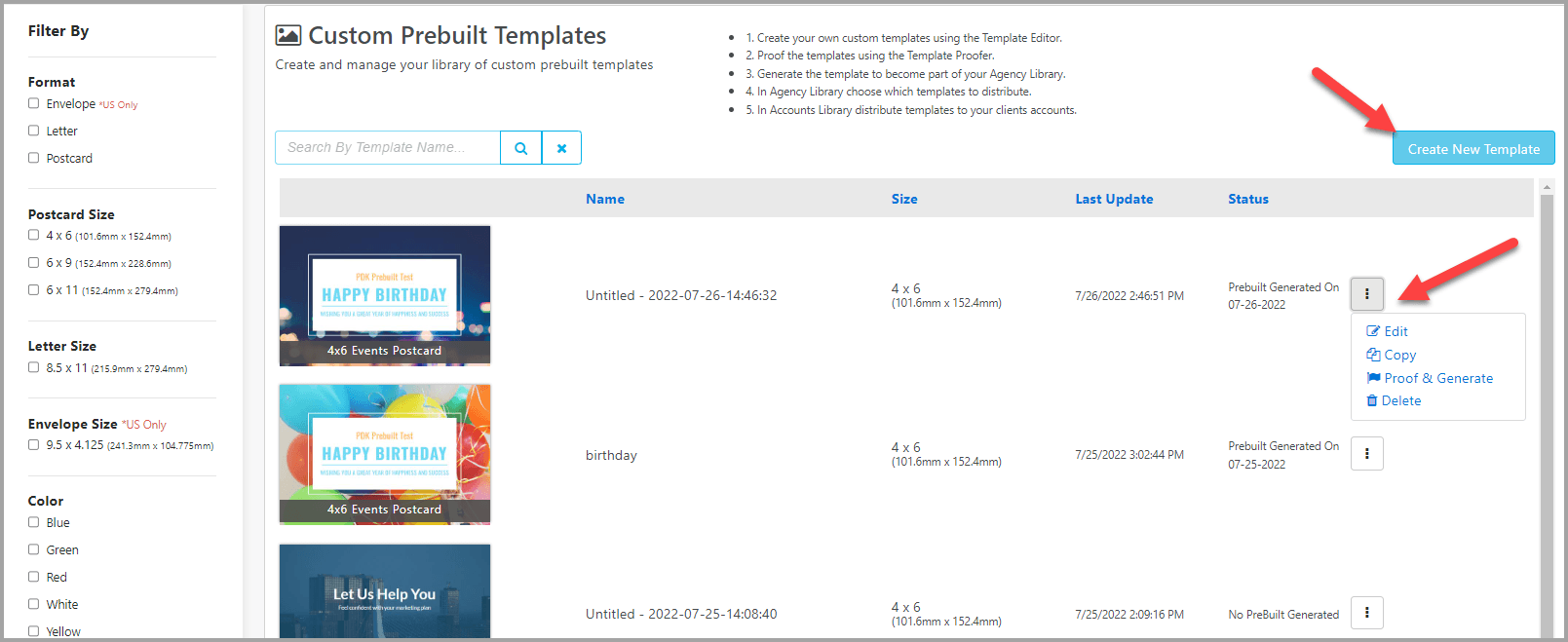
Once templates are saved, they can be edited, copied and proofed the same way you can manage templates in client accounts. There’s one additional step involved here, the Generate process. This will enable you to name & tag templates with descriptions for use with filtering tools that you’ll access in other parts of the templating system.
Agency Library
Once you’ve proofed and generated your custom templates, they’re inserted into the Agency Library, which also contains all of the free, Prebuilt templates that Postalytics provides you.
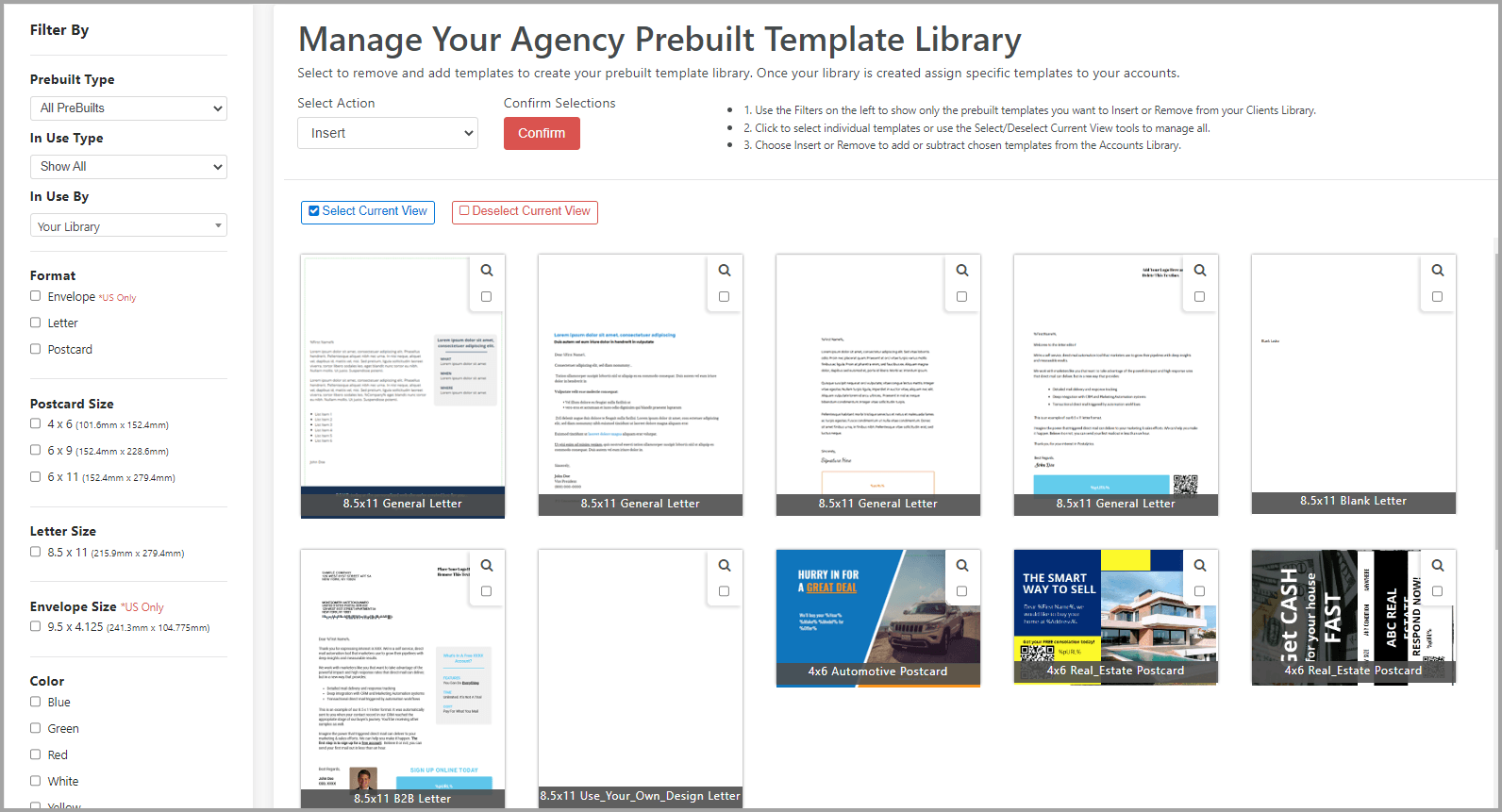
The Agency Library is a collection of all of the possible templates that you can assign to client accounts. You can select which of the templates you want to insert or remove from the Accounts Library.
Accounts Library
The Accounts Library contains all of the templates that you’ve chosen to make available to any of your client accounts., from your Agency Library. From here, you can pick and choose which templates will appear in each or all of your client accounts prebuilt libraries.
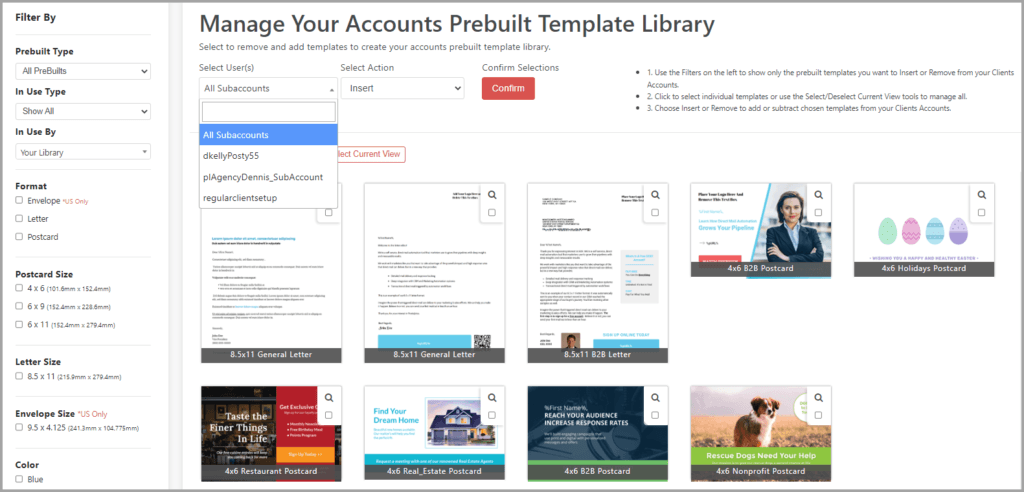
This centralized management and control over the template distribution process is a huge advance, and it should help Agency Edition customers scale their creative efforts tremendously.
Other New Agency Level Tools
We’ve also added a few new features that will help Agency Edition customers manage their accounts more efficiently.
Invite New Clients by Email
If you’re model calls for your client accounts to be highly self-service in nature, you might want to use the new email invitation method to invite clients to set up their own new client accounts. Now, when you add a new client account, you can choose to set them up yourself (the same as before) or to invite a client to join via email invitation.
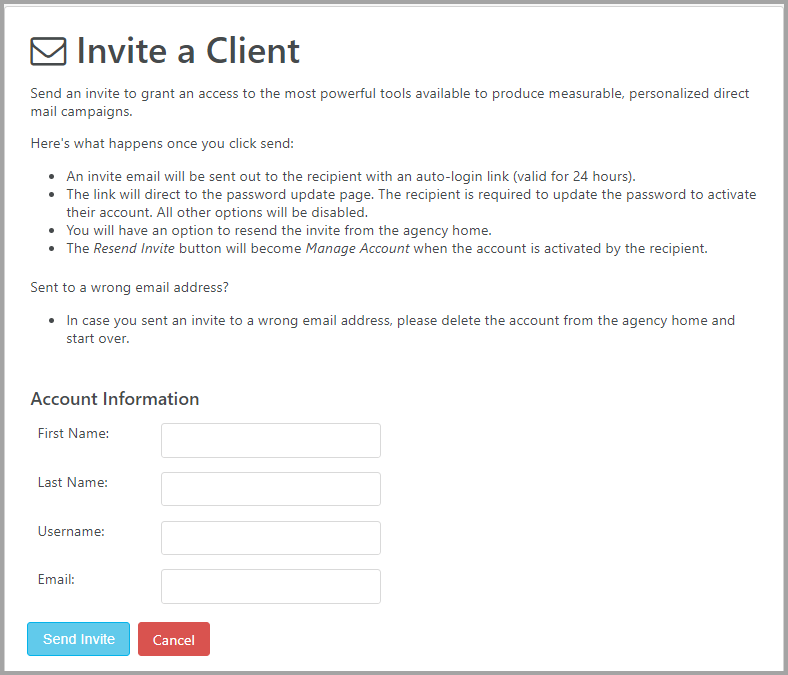
The email invitation will include an auto-login link that is good for 24 hours. When the client clicks on the link, they’ll be directed to a page where they can establish their password and begin setting up their account. You’ll see invited clients that haven’t completed the process on the Agency Home Dashboard.

New Home Dashboard Organization Tools
As Agency Edition clients have scaled up their operations the Home Dashboard listing of client accounts in one very long page has become unmanageable. Now, the page will be limited in the number of client accounts displayed on any page, and we’ve added a search feature to quickly find a client account to begin working on.
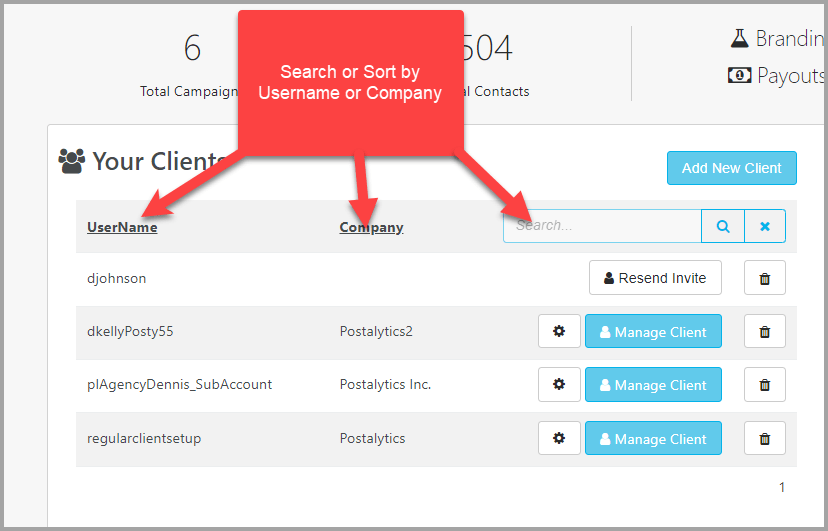
Nonprofit (U.S.) and Self-funded (U.S. and Canada) Postage Permits
In addition to all of the Agency Edition centric changes, we’ve also enabled new tools for qualified U.S. nonprofit organizations to register their USPS postage discount information with us to take advantage of special USPS discounts on eligible campaigns. We’ve also created a system to utilize the postage permits that have been issued by Canada Post or the USPS for mailers that want to use their own postage permits. This will be covered in more detail in an upcoming webinar and blog post. If you have questions about these new options in the meantime, please reach out to us.
We’re really excited to release this new version of the Postalytics Agency Edition so that our clients can continue to scale their businesses. Stay tuned for more great product announcements as 2022 rolls on. If you’ve got product enhancement ideas, we’d love to hear from you!
About the Author

Dennis Kelly
Dennis Kelly is CEO and co-founder of Postalytics, the leading direct mail automation platform for marketers to build, deploy and manage direct mail marketing campaigns. Postalytics is Dennis’ 6th startup. He has been involved in starting and growing early-stage technology ventures for over 30 years and has held senior management roles at a diverse set of large technology firms including Computer Associates, Palm Inc. and Achieve Healthcare Information Systems.
